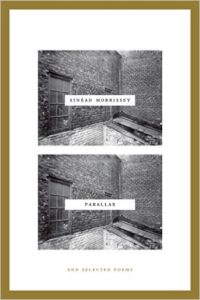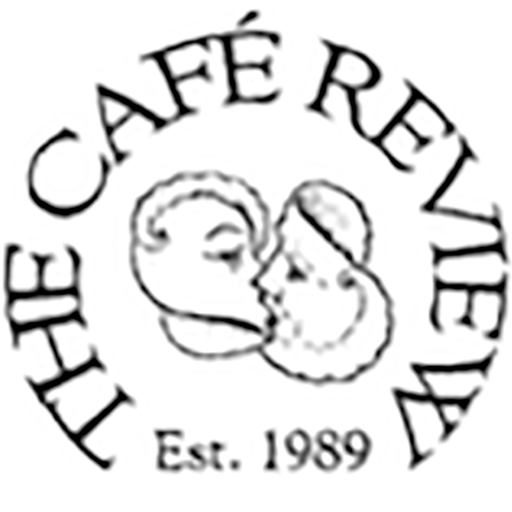Parallax
 by Sinéad Morrissey,
by Sinéad Morrissey,
Carcanet Press Limited, 2013,
69 pages, paper, £9.95 ($15.56 USD),
ISBN: 978-1-84777-204-6
Buy the Book
Hold your finger out in front of you, close one eye, then quickly open it and close the other. Rapidly switching back and forth, you will see your finger shift from left to right and back again. This displacement, or shift in apparent position of your finger seen from different points of view, is parallax. Parallax is measured by the angle of inclination between these two points of view and the object. Astronomers use the principle of parallax to measure the distances to closer stars, and photographers know parallax error as the difference between what is seen through the viewfinder and what is captured by the lens in a single-lens reflex camera. It is this reference, to the shifts that affect optical perception, that is initially most applicable to the poems in Sinéad Morrissey’s extraordinary collection Parallax, the winner of the 2013 T. S. Eliot Prize.
Inspired initially by the discovery of a trove of 1911 plate glass negatives of Belfast’s slums taken by Alexander Robert Hogg, Morrissey’s poems use ekphrasis to confront the radical possibilities of seeing and not seeing, of truths and lies, and of looking at and looking away. The poems are replete with photography and film, with television screens and early viewing devices, with blindness and light. In “The Mutoscope,” early motion picture viewing devices rattle to life for the singular viewer:
Only for you do the two mute girls on stage
who falter at first, erratic as static
in the synaptic gap between each image,
imperceptibly jolt to life —
grinning, tap-dancing, morphing into footage,
their arms like immaculate pistons, their legs like knives . . .
It lasts a minute, their having-been-written onto light.
Morrissey’s use of internal rhyme punctuates the poem as it, like the mutoscope, picks up speed. This rhythmic coming to light, and to life, is repeated throughout the volume, often in contrast to a reciprocal darkening. In “Home Birth,” as in “A Matter of Life and Death,” the arrival of one person eclipses another. In the latter poem, the actor David Niven flickers across the 1946 film of the same title, ascending a giant stairway to heaven as the speaker in the poem gives birth and recalls the recent death of her grandmother.
The poems navigate these exits and entrances, and questions of perspective, through masterful poetic form. In “Fur” we discover Holbein’s famous anamorphic skull, appearing as “driftwood / up-ended by magic from the right hand-side / of the tesserae carpet” in his 1533 painting, The Ambassadors. And even as the speaker in “Photographing Lowry’s House,” a persona poem imagining the experience of photographer Denis Thorpe, recognizes the effect of erasure his photographs simultaneously have on the artist’s life — as breath has on drawings of fawns in the caves of Lascaux — other actors in the poems engage in more willful concealment and erasures. For example, “The Doctors” imagines photographic alterations in Soviet-era Russia before Photoshop: “With scissors, / nail files, ink and sellotape, he has been vanished — / alongside other party operatives who touched / his sleeve.”
Throughout Parallax, in addition to poems that regard photography and film, there are other poems that explore Russia from differing perspectives. The sonnet “Puzzle” responds to a popular 1950s Soviet book of mathematical puzzles, and “Shostakovitch” imagines the composer writing under the restrictions of the Great Terror. Metaphorically and philosophically, parallax can also be considered a literary tool by which an author presents the same story from different points of view.
From one man’s sudden onset of blindness, to wanting to look away from flies on a dead rat, to a speaker’s observations in the poem “Shadows” that they “retract [ . . . ] back like drowning soap,” the interdependent play of light and darkness is revealed, and the double nature of light leaves its mark: “Shadows of candles on church walls at Evensong / manifest not as flame, but as smoke.” In “Lighthouse,” the speaker’s son lies awake at ten in the waning light of late summer solstice,
a lighthouse starts its own nightlong address
in fractured signaling; it blinks and bats
the swingball of its beam, then stands to catch,
then hurls it out again beyond its parallax.
Here, counting “each creamy loop” and “each well-black interval,” the boy enters a world that is only partly visible, “partly seen.”
Because our eyes have different and overlapping fields of vision, parallax is what allows us, through stereopsis, to perceive the world in three dimensions. This effect is what the poems in this volume full of electricity offer us: more seeing, more revelation and doubt, greater depth.
— Julie Poitras Santos

